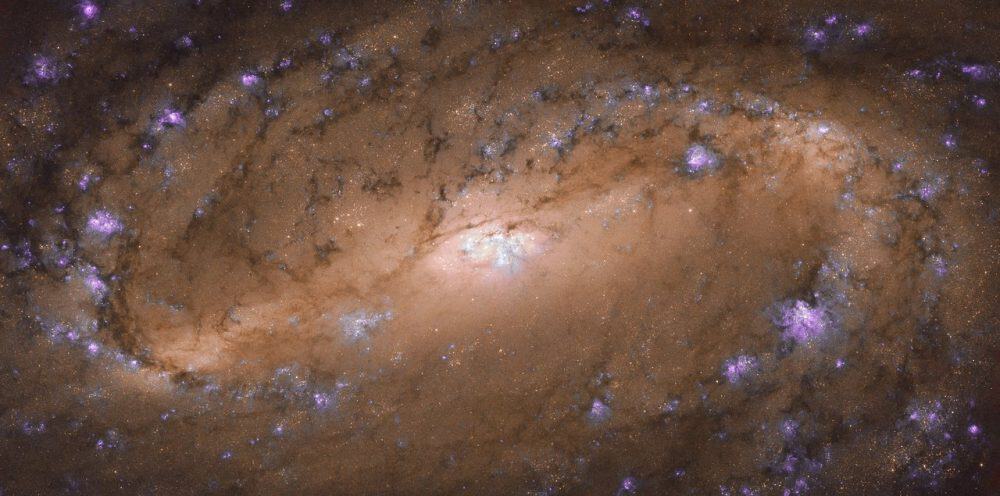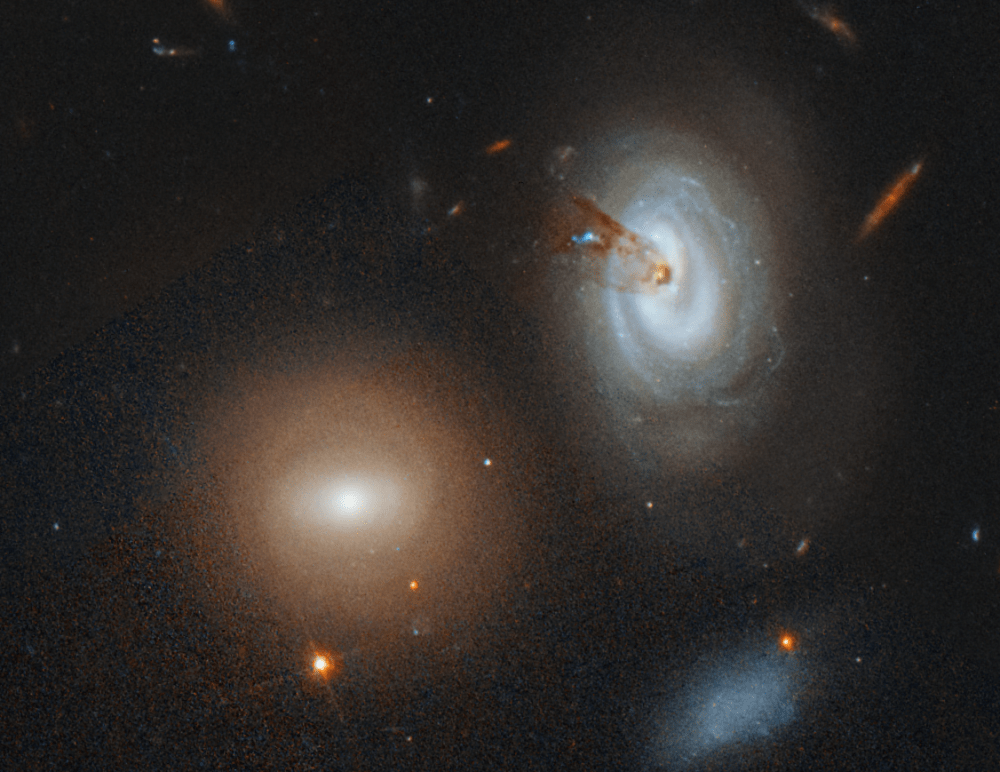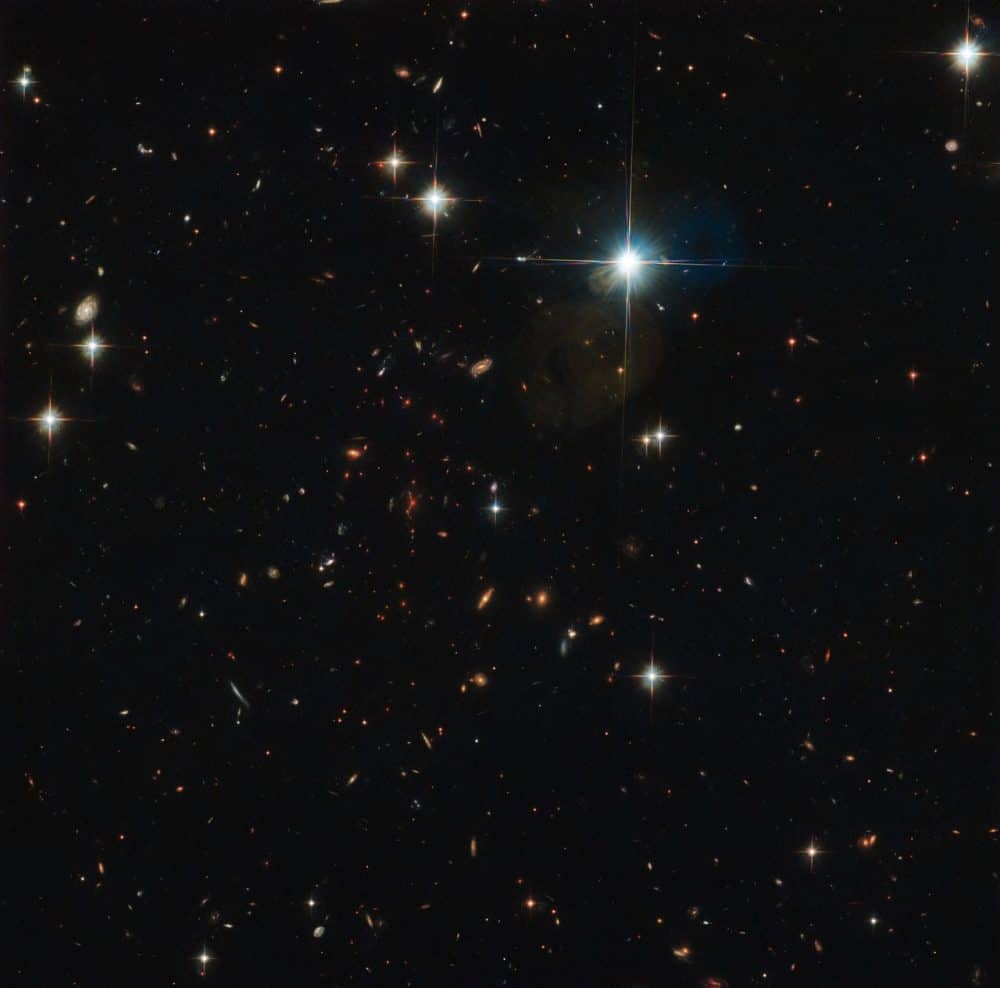Blog
NGC 2903 is located about 30 million light-years away in the constellation of Leo (The Lion), and was studied as part of a Hubble survey of the central regions of roughly 145 nearby disc galaxies. This study aimed to help astronomers better understand the relationship between the black holes that lurk at the cores of galaxies like these, and the rugby-ball-shaped bulge of stars, gas, and dust at the galaxy’s centre — such as that seen in this image.
NGC 2903 is a field barred spiral galaxy about 30 million light-years away in the constellation Leo. It was discovered by William Herschel who cataloged it on November 16, 1784. NGC 2903 has a very high rate of star formation in its central region. NGC 2905 is a bright star cloud within this galaxy. NGC 2903 is part of the Virgo Supercluster.
more...Eric Victor Burdon (born 11 May 1941) is an English singer-songwriter and actor. He was previously the vocalist of rock band The Animals and funk band War. He is regarded as one of the British Invasion‘s most distinctive singers with his deep, powerful blues-rock voice. He is also known for his aggressive stage performances.
In 2008, he was ranked 57th in Rolling Stone‘s list The 100 Greatest Singers of All Time. Burdon was lead singer of the Animals, formed during 1962 in Newcastle upon Tyne. The original band was the Alan Price Rhythm and Blues Combo, which formed in 1958;[10] they became the Animals shortly after Burdon joined the band. The Animals combined electric blues with rock and in the USA were one of the leading bands of the British Invasion.[11] Along with the Beatles, the Rolling Stones, the Who, the Hollies, the Dave Clark Five, and the Kinks, the group introduced British music and fashion. Burdon’s powerful voice can be heard on the Animals’ singles “The House of the Rising Sun“, “Baby Let Me Take You Home“, “I’m Crying“, “Boom Boom“, “Don’t Let Me Be Misunderstood“, “Bring It On Home to Me“, “We Gotta Get out of This Place“, “It’s My Life“, “Don’t Bring Me Down“, “See See Rider“, “Monterey“, and “Sky Pilot“.
more...
Carla Bley (born Lovella May Borg, May 11, 1936) is an American jazz composer, pianist, organist and bandleader. An important figure in the free jazz movement of the 1960s, she is perhaps best known for her jazz opera Escalator over the Hill (released as a triple LP set), as well as a book of compositions that have been performed by many other artists, including Gary Burton, Jimmy Giuffre, George Russell, Art Farmer, John Scofield and her ex-husband Paul Bley.
Bley was born in Oakland, California to Emil Borg (1899–1990), a piano teacher and church choirmaster, who encouraged her to sing and to learn to play the piano, and Arline Anderson (1907–1944), who died when Bley was eight years old. After giving up the church to immerse herself in roller skating at the age of fourteen, she moved to New York at seventeen and became a cigarette girl at Birdland, where she met jazz pianist Paul Bley.
more...Born 5-11-1916 Died march 21 2016
After serving in the U.S. Air Force, he became a musician. He was a studio musician and played with many famous artists such as Connie Smith, Pee Wee King and the Osborne Brothers. He also produced many of his own recordings. He won the Champion of Champions Thumb Picking Contest in Central City Kentucky and was inducted into the Kentucky Music Hall of Fame, and performed regularly at The Ozark Folk Center in Mountain View, Ark. with Sassafras Moon.
He is survived by his wife, Theda Mullins of Vicksburg; son, Mark Mullins of North Carolina; five brothers; five sisters; and one grandchild. In 1985, he won the National Merle Travis Tribute thumbpicking contest at the Ozark Folk Center in Arkansas.
He captured top honors in 1991 at the International Thumbpicking Contest in Central City, Ky.
Then, in a special 1996 contest allowing only the former international champions to compete, Mullins won first place as the “Champion of Champions.”
On a recent morning, Mullins scoots a kitchen chair into the living room and grabs his favorite guitar, made by master builder Dumitru Manea of Nashville, Tenn.
“I won this in a contest, by the way, and it’s an incredible instrument,” Mullins says.
He soon inserts his right thumb into a pick and launches into “Hello, My Baby,” which has a simple ragtime quality to it.
His thumb beats out the bass rhythm, and those fingers with the fake nails seem to make a sound of several instruments in harmony.
more...
Bakino Faso
more...https://www.youtube.com/watch?v=R0mUnt1kPhs
more...The spiral galaxy D100, on the far right of this Hubble Space Telescope image, is being stripped of its gas as it plunges toward the center of the giant Coma galaxy cluster.
The dark brown streaks near D100’s central region are silhouettes of dust escaping from the galaxy. The dust is part of a long, thin tail, also composed of hydrogen gas, that stretches like taffy from the galaxy’s core. Hubble, however, sees only the dust. The telescope’s sharp vision also uncovered the blue glow of clumps of young stars in the tail. The brightest clump in the middle of the tail (the blue feature) contains at least 200,000 stars, fueled by the ongoing loss of hydrogen gas from D100.
The gas-loss process occurs when D100, due to the pull of gravity, begins falling toward the dense center of the massive Coma cluster, consisting of thousands of galaxies. During its plunge, D100 plows through intergalactic material like a boat plowing through water. This material pushes gas and dust out of the galaxy. Once D100 loses all of its hydrogen gas, its star-making fuel, it can no longer create new stars. The gas-stripping process in the beleaguered galaxy began roughly 300 million years ago.
The reddish galaxies in the image contain older stars between the ages of 500 million to 13 billion years old. One of those galaxies is D99, just below and to the left of D100. It was stripped of its gas by the same process as the one that is siphoning gas from D100. The blue galaxies contain a mixture of young and old stars. Some of the stars are less than 500 million years old. The Coma cluster is located 330 million light-years from Earth.
more...David Thomas Mason (born 10 May 1946) is an English singer-songwriter and guitarist from Worcester, who first found fame with the rock band Traffic. Over the course of his career, Mason has played and recorded with many notable pop and rock musicians, including Paul McCartney, George Harrison, the Rolling Stones, Jimi Hendrix, Eric Clapton, Michael Jackson, David Crosby, Graham Nash, Steve Winwood, Fleetwood Mac, Delaney & Bonnie, Leon Russell and Cass Elliot. One of Mason’s best known songs is “Feelin’ Alright“, recorded by Traffic in 1968 and later by many other performers, including Joe Cocker, whose version of the song was a hit in 1969. For Traffic, he also wrote “Hole in My Shoe“, a psychedelic pop song that became a hit in its own right. “We Just Disagree“, Mason’s 1977 solo US hit, written by Jim Krueger, has become a staple of US classic hits and adult contemporary radio playlists.
In 2004, Mason was inducted into the Rock and Roll Hall of Fame as a founding member of Traffic.
more...Jimmy Ponder (May 10, 1946 – September 16, 2013) was an American jazz guitarist.
When Ponder’s brother entered the military, he left his guitar, and Ponder picked it up. In his early teens he received lessons from the guitarist in a band for which he sang doo-wop. He was drawn to the jazz guitar he heard on the radio. While playing in a rhythm and blues band, he occasionally inserted a jazz solo. He considers hearing guitarist Thornel Schwartz an important part of his life, when Schwartz was playing with organist Jimmy McGriff. He was impressed by Pat Martino when he saw Martino in the Jack McDuff band. He also cites as influences George Benson, Kenny Burrell, and Rene Thomas, though none surpassed the impact of seeing Wes Montgomery.
He learned the guitar solo from “Daily Double” (Choice), the only 45 rpm single released by Charles Earland. When Earland performed in Pittsburgh, he invited Ponder to sit-in with the band and liked what he heard. Earland promised Ponder he could become a member of the band after he finished high school. Six months after graduating, he was hired by Earland.
He began playing with Earland at 17 and in the following years with Lou Donaldson, Houston Person, Donald Byrd, Stanley Turrentine, and Jimmy McGriff. He moved to Philadelphia and later New York City in the 1970s and recorded extensively as a leader. Since the late 1980s, he frequently returned to his hometown to perform with his trio of two other Pittsburgh musicians, Gene Ludwig and Roger Humphries. Ponder’s highest charting release was Somebody’s Child, which reached No. 3 on the JazzWeek airplay chart in 2007.
more...Melvin Sokoloff (May 10, 1929 – February 2, 1990), known professionally as Mel Lewis, was an American jazz drummer, session musician, professor, and author. He received fourteen Grammy Award nominations.
https://www.youtube.com/watch?v=VstVan4XhyE
more...
Flamenco Fridays with Rumba.
Rumba flamenca was primarily influenced by guaracha, an uptempo style of vocal music which originated in Havana‘s musical theatre. Some elements from Cuban rumba were also incorporated, although minor, despite the name. Although unlikely, both guaracha and Cuban rumba might have been influenced by flamenco earlier in the 19th century. Guarachas can be traced back to the Spanish jácaras, thus justifying the classification of rumba flamenca as a cante de ida y vuelta.
The first rumba flamenca recordings were made by La Niña de los Peines in the 1910s. During the late 20th century, Paco de Lucía, together with percussionist Rubem Dantas, incorporated Afro-Peruvian musical elements such as the cajón (wooden box) and certain rhythms.
more...https://www.youtube.com/watch?v=wya2TN0hzLo
more...Dotted across the sky in the constellation of Pictor (The Painter’s Easel) is the galaxy cluster highlighted here by the NASA/ESA Hubble Space Telescope: SPT-CL J0615-5746, or SPT0615 for short. First discovered by the South Pole Telescope less than a decade ago, SPT0615 is exceptional among the myriad clusters so far catalogued in our map of the Universe — it is the highest-redshift cluster for which a full, strong lens model is published.
SPT0615 is a massive cluster of galaxies, one of the farthest observed to cause gravitational lensing. Gravitational lensing occurs when light from a background object is deflected around mass between the object and the observer. Among the identified background objects, there is SPT0615-JD, a galaxy that is thought to have emerged just 500 million years after the Big Bang. This puts it among the very earliest structures to form in the Universe. It is also the farthest galaxy ever imaged by means of gravitational lensing.
Just as ancient paintings can tell us about the period of history in which they were painted, so too can ancient galaxies tell us about the era of the Universe in which they existed. To learn about cosmological history, astronomers explore the most distant reaches of the Universe, probing ever further out into the cosmos. The light from distant objects travels to us from so far away that it takes an immensely long time to reach us, meaning that it carries information from the past — information about the time at which it was emitted.
By studying such distant objects, astronomers are continuing to fill the gaps in our picture of what the very early Universe looked like, and uncover more about how it evolved into its current state.
more...Anthony Wilson (born May 9, 1968) is a jazz guitarist, arranger and composer. He is the son of bandleader Gerald Wilson. Born in Los Angeles on May 9, 1968, Wilson received his degree in music composition from Bennington College. His first major breakthrough was as lead guitarist of the group, Storm in 1980. He counts Duke Ellington, Gil Evans, Wes Montgomery, Ry Cooder, and T-Bone Walker among his influences. His first album Anthony Wilson was nominated for a Grammy Award and his second album, Goat Hill Junket (1998) also received praise. Albums with his nine-piece band include Adult Themes (MAMA, 1999) and Power of Nine (Groove Note, 2006). Diana Krall and mandolinist Eva Scow appear on the latter.
He has also recorded two trio albums with Hammond organist Joe Bagg and drummer Mark Ferber, Our Gang in 2001 and Savivity in 2005 (both on Groove Note). In 2009 he recorded more organ trio music with Jack of Hearts (again for Groove Note) featuring Larry Goldings on Hammond organ, and alternating drummers Jim Keltner and Jeff Hamilton.
As a composer, he has received commissions from the International Association for Jazz Education, the Henry Mancini Institute, Jazz at Lincoln Center, and luthier John Monteleone. His guitar quartet song cycle “Seasons” was composed as a vehicle for Monteleone’s quartet of guitars called “The Four Seasons” which were included in the Metropolitan Museum of Art’s 2011 exhibition “Guitar Heroes.” “Seasons” was released as an audio CD and live performance film DVD set on Wilson’s label Goat Hill Recordings in November 2011. Another 2011 album, recorded in Brazil, was “Campo Belo” (Goat Hill Recordings), featuring rising Brazilian music stars André Mehmari (piano and accordion), Edu Ribeiro (drums), and Guto Wirtti (bass).
more...Dennis Milton Chambers (born May 9, 1959) is an American drummer. He was inducted into the Modern Drummer Hall of Fame in 2001. Chambers was born on May 9, 1959. He began drumming at the age of four years, and was gigging in Baltimore-area nightclubs by the age of six. He was recruited in 1981 by the Sugar Hill Label to be their “house drummer.” Chambers played on many Sugar Hill releases — sounds like Keith LeBlanc [not Chambers], who was the Original Sugar Hill Rhythm Section drummer [“White Lines,” “The Message,” “8th Wonder,” and so on], with Skip McDonald (guitar) and Doug Wimbish (bass)]. Contrary to popular belief he did not play on “Rapper’s Delight” which was revealed in a recent interview on Drumeo.com on 6/8/2017.
In an interview by Bonedo in 2011, Chambers was asked who some of his influences and favorite drummers were and he mentioned Clyde Stubblefield, Al Jackson Jr., Steve Gadd, Vinnie Colaiuta, Gary Husband, Jack Dejohnette, Billy Cobham, Buddy Rich, Elvin Jones, Roy Haynes, and Tony Williams.
In 1978 (at 18 years old) he joined Parliament/Funkadelic, and stayed with them until 1985. In 1986 he joined the John Scofield band. Since then he has played with most of the major figures in jazz fusion music.
He has recorded and performed with Tommy Coster, John Scofield, George Duke, Victor Wooten, Brecker Brothers, Santana, Parliament/Funkadelic, John McLaughlin, Niacin, Mike Stern, CAB, Greg Howe, and many others.
He has toured extensively with Carlos Santana and makes appearances with his band Niacin.
more...
Aaron Corthen, better known as A.C. Reed (May 9, 1926 – February 24, 2004) was an American blues saxophonist, closely associated with the Chicago blues scene from the 1940s into the 2000s. Reed was born in Wardell, Missouri, and grew up in southern Illinois. He took his stage name from his friend Jimmy Reed. He moved to Chicago during World War II, playing with Earl Hooker and Willie Mabon in the 1940s. He toured with Dennis “Long Man” Binder in 1956 and worked extensively as a sideman for Mel London‘s blues record labels Chief/Profile/Age in the 1960s, with Lillian Offitt and Ricky Allen, among others. He had a regionally popular single in 1961, “This Little Voice” (Age 29101), and cut several more singles over the course of the decade.
He became a member of Buddy Guy‘s band in 1967, playing with him on his tour of Africa in 1969 and, with Junior Wells, opening for the Rolling Stones in 1970. He remained with Guy until 1977. He then played with Son Seals and Albert Collins in the late 1970s and 1980s. He began recording solo material for Alligator Records in the 1980s. His 1987 album, I’m in the Wrong Business, includes cameo appearances by Stevie Ray Vaughan and Bonnie Raitt.
more...More Posts
- Vic Juris Day
- Gary Bartz Day
- George Gershwin Day
- World Music with Aziza Brahim
- Daily Roots with the Paragons
- The Cosmos with IC 5070
- Sam Rivers Day
- Shadow Wilson Day
- Dmitri Shostakovich Day
- World Music with Treacherous Orchestra
- Daily Roots with The Clarendonians
- Robert Hunter Passes
- The Cosmos with NGC 4535
- Ahmed Ratio Day
- Blind Lemon Jefferson Day
- Fats Navarro Day
- World Fusion with Catrin Finch and Sekou Keita
- Daily Roots with Earl Dunkley
- Diego LaBriola Day
- The Cosmos with NGC 986



